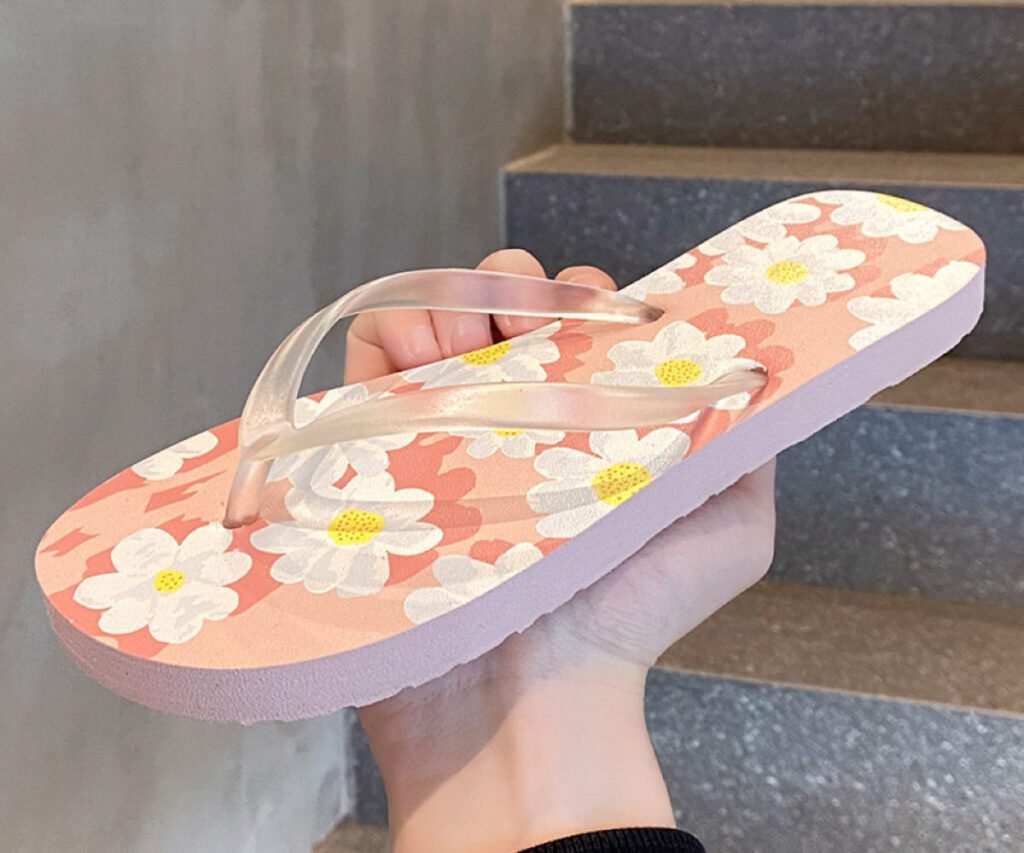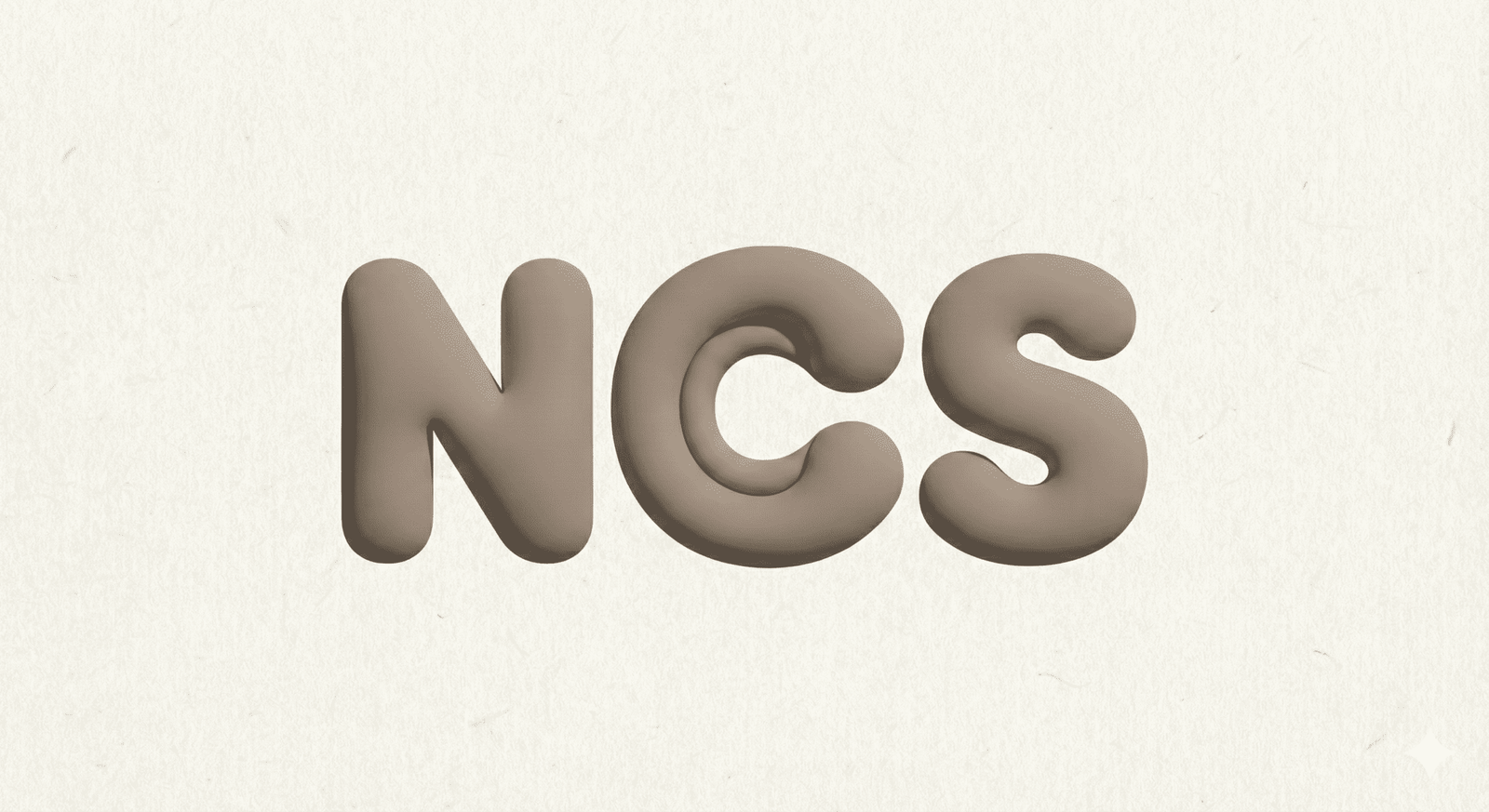Why Choose us?

Low MOQ
Small MOQ is available and you can purchase different types in one batch

Fast Delivery
We’re so confident in our slippers that we offer a 7-15 day lead time on all orders.
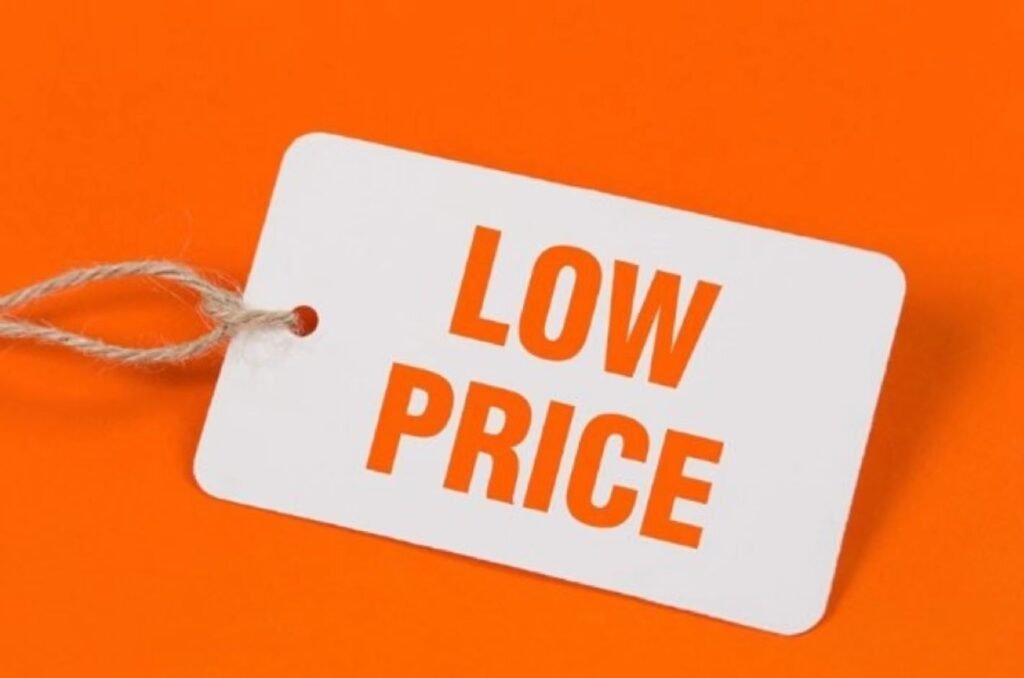
Competitive Price
We always provide high-quality slippers at an affordable price.
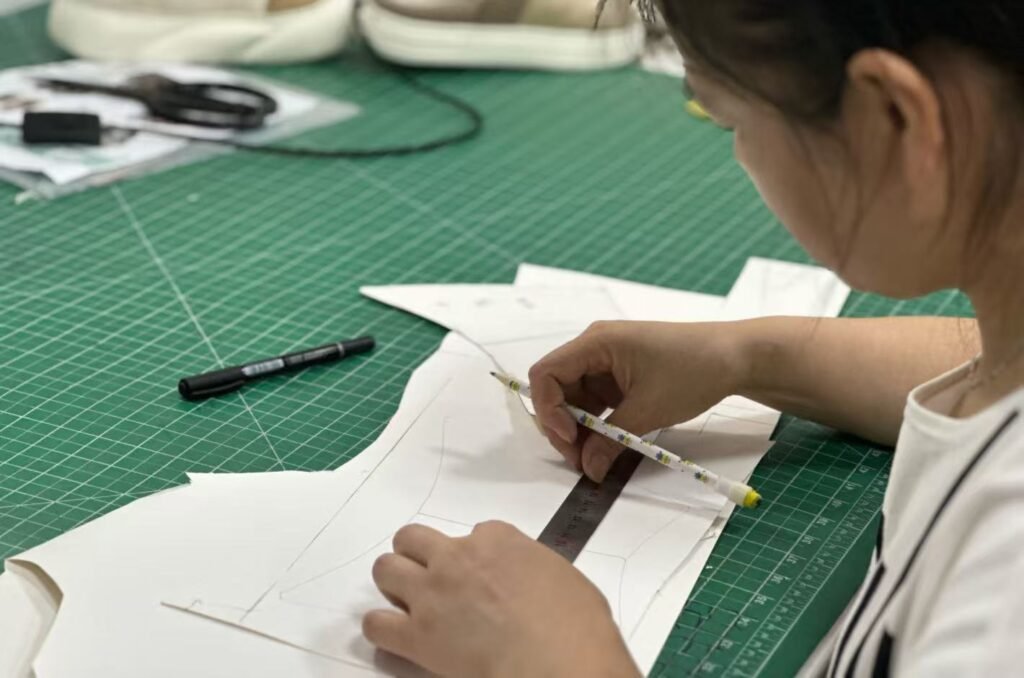
OEM/ODM
We have a team of experts who can help you find the perfect solution for your needs.

Customer Service
We’ll get you the answers to all of your questions, quickly and effectively

Easy Communication
We think in your ways. Consider your requirements in priority and how to meet them.
100+ Knowledge You Need to Know About Flip Flop Plastic Slippers
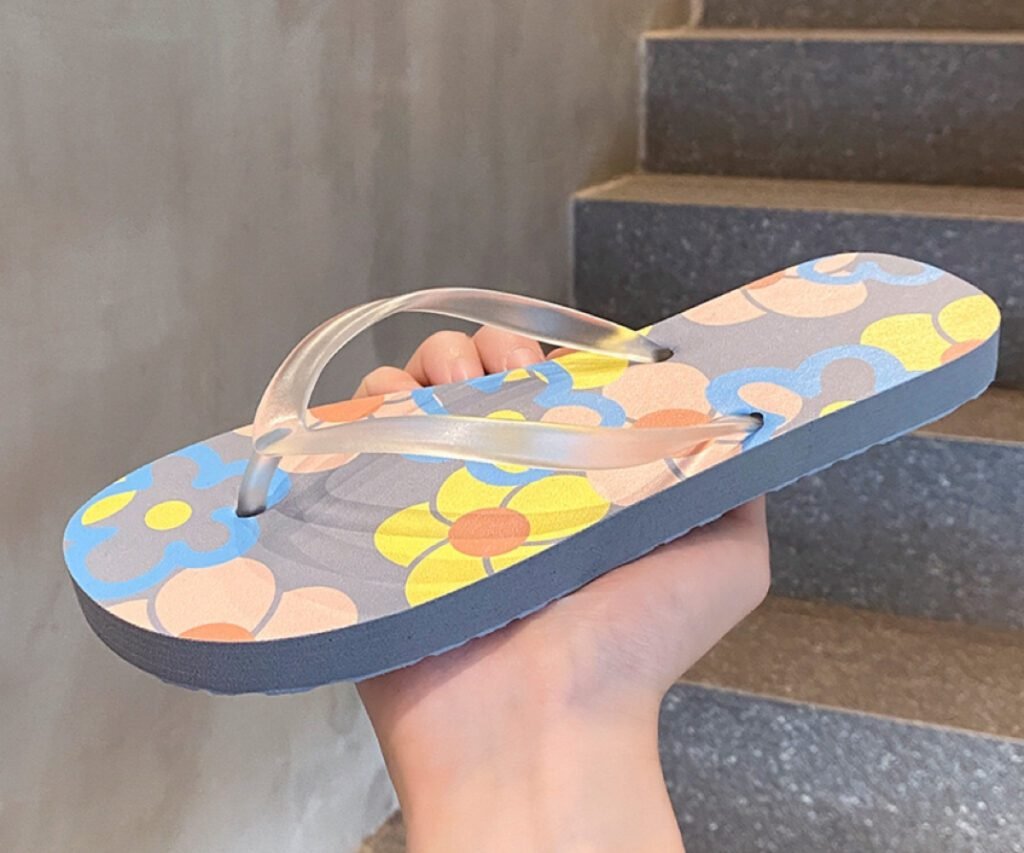
Material Selection
1.What kind of flip flop material is best for long-term wear?
### 1. **EVA (Ethylene Vinyl Acetate)**
– **Characteristics**:
– EVA is lightweight, flexible, and provides excellent shock absorption, making it a popular choice for flip-flops.
– It has a cushioned feel and returns to shape quickly after compression.
– **Comfort Level**:
– EVA flip-flops are very comfortable due to their shock-absorbing properties, which reduce impact on feet and joints.
– They are ideal for prolonged wear as they minimize foot fatigue.
– **Durability**:
– EVA is moderately durable and suitable for all-day indoor and light outdoor use, though it may wear down faster on rough surfaces.
– **Best Use**: Comfortable and supportive, EVA flip-flops are great for both indoor and light outdoor use, providing a balance between comfort and affordability.
### 2. **Memory Foam**
– **Characteristics**:
– Memory foam molds to the shape of the foot, providing a customized and soft feel.
– It offers excellent cushioning and adapts to pressure, which helps with shock absorption.
– **Comfort Level**:
– Memory foam flip-flops provide a plush feel, reducing pressure on the feet, especially in the heel and arch.
– They are very comfortable for all-day wear, especially for standing or walking on hard surfaces.
– **Durability**:
– Memory foam can flatten over time with prolonged use, so it’s best for moderate, indoor wear.
– **Best Use**: Ideal for extended indoor use or light outdoor activities, especially if comfort is the top priority.
### 3. **Rubber (Natural or Synthetic)**
– **Characteristics**:
– Rubber is durable, flexible, and water-resistant, making it suitable for various environments.
– Natural rubber offers more softness and flexibility, while synthetic rubber tends to be firmer.
– **Comfort Level**:
– Rubber provides good cushioning and support, making it comfortable for all-day wear.
– It’s also slip-resistant, adding stability for prolonged wear on various surfaces.
– **Durability**:
– Rubber is highly durable and suitable for outdoor use, even on rough or wet surfaces, making it long-lasting.
– **Best Use**: Excellent for outdoor use, beach, poolside, and areas with moisture, providing both comfort and durability for long wear.
### 4. **Cork or Cork Blends**
– **Characteristics**:
– Cork is a natural material with excellent shock-absorbing properties, often combined with EVA or latex for added flexibility.
– It molds to the shape of the foot over time, offering a personalized fit.
– **Comfort Level**:
– Cork is supportive and comfortable, especially for people with sensitive feet, as it reduces pressure on pressure points.
– Its natural breathability and moisture-wicking properties keep feet dry and cool.
– **Durability**:
– Cork is durable and long-lasting, especially when blended with other materials like EVA for extra flexibility.
– **Best Use**: Ideal for prolonged indoor and outdoor wear, particularly for those looking for a natural, breathable option with moderate arch support.
### 5. **PU (Polyurethane)**
– **Characteristics**:
– PU is a durable, flexible material with high shock absorption and resilience.
– It provides more structure and support than softer materials like EVA.
– **Comfort Level**:
– PU flip-flops offer good arch support, making them suitable for those with foot support needs.
– They retain their shape and cushioning over time, providing consistent comfort for prolonged wear.
– **Durability**:
– PU is highly durable and withstands regular wear, making it suitable for outdoor use on a variety of surfaces.
– **Best Use**: Great for everyday outdoor wear, especially for those who need extra arch support and consistent cushioning.
### 6. **Leather (Natural or Vegan)**
– **Characteristics**:
– Leather is a durable, breathable, and natural material that offers comfort and flexibility.
– Vegan leather alternatives provide similar durability and flexibility while being animal-friendly.
– **Comfort Level**:
– Leather molds to the foot over time, providing a customized fit that enhances comfort.
– It’s naturally breathable, preventing sweat buildup, which keeps feet cool for extended wear.
– **Durability**:
– Leather is very durable and long-lasting, particularly for casual and light outdoor use.
– It requires occasional care to prevent cracking or drying out.
– **Best Use**: Suitable for casual long-term wear, providing breathability and a classic look, ideal for moderate indoor and outdoor use.
2.What materials are suitable for summer?
### 1. **EVA (Ethylene Vinyl Acetate)**
– **Characteristics**:
– EVA is lightweight, flexible, and has good cushioning, making it a popular choice for summer flip-flops.
– It is water-resistant, dries quickly, and provides a comfortable, cushioned feel for prolonged wear.
– **Advantages for Summer**:
– EVA flip-flops are ideal for summer as they prevent foot fatigue and keep feet cool due to their lightweight nature.
– They are perfect for casual wear at the beach, pool, or for everyday summer use.
– **Best Use**: Beachwear, poolside, casual summer activities.
### 2. **Rubber (Natural or Synthetic)**
– **Characteristics**:
– Rubber is durable, slip-resistant, and waterproof, making it suitable for outdoor and water-related activities.
– Natural rubber provides better flexibility, while synthetic rubber offers extra durability.
– **Advantages for Summer**:
– Rubber flip-flops handle moisture well and won’t become slippery, even when wet, making them ideal for pool or beach use.
– They are easy to clean and dry quickly, providing traction on wet surfaces.
– **Best Use**: Outdoor activities, beach, poolside, water sports.
### 3. **Cork**
– **Characteristics**:
– Cork is a natural material known for its lightweight, shock-absorbing properties, and breathability.
– It molds to the foot shape over time, providing personalized comfort.
– **Advantages for Summer**:
– Cork absorbs moisture, preventing sweat buildup and keeping feet dry.
– Its natural breathability and cushioning make it a comfortable choice for hot weather.
– **Best Use**: Casual summer wear, especially for walking or spending extended time outdoors.
### 4. **PU (Polyurethane)**
– **Characteristics**:
– PU is lightweight, flexible, and resilient, offering good support and durability.
– It maintains its shape well and provides better arch support than softer materials.
– **Advantages for Summer**:
– PU flip-flops offer stability and comfort for all-day wear, even in hot conditions.
– They are resistant to water and dry quickly, making them suitable for a variety of summer activities.
– **Best Use**: Walking, casual outings, and activities requiring extra foot support.
### 5. **Foam (High-Density or Memory Foam)**
– **Characteristics**:
– Foam provides a soft, cushioned feel and absorbs impact, reducing pressure on the feet.
– High-density foam retains shape well and provides more durability than standard foam.
– **Advantages for Summer**:
– Foam flip-flops are lightweight and provide a plush feel that remains comfortable in hot weather.
– Memory foam options conform to the foot shape, offering custom comfort for extended wear.
– **Best Use**: Indoor wear, light outdoor activities, lounging.
### 6. **Neoprene**
– **Characteristics**:
– Neoprene is a flexible, water-resistant material often used in water sports equipment.
– It is soft, cushioned, and dries quickly, making it comfortable for wet conditions.
– **Advantages for Summer**:
– Neoprene is suitable for water-related activities, as it maintains grip and comfort even when wet.
– It is lightweight and dries quickly, reducing the risk of chafing or discomfort.
– **Best Use**: Beach, poolside, water sports, and activities involving frequent water exposure.
### 7. **Mesh Fabric**
– **Characteristics**:
– Mesh is a breathable, lightweight fabric that allows airflow, keeping feet cool and dry.
– Often combined with other materials for added structure and support.
– **Advantages for Summer**:
– Mesh provides excellent breathability, reducing sweat buildup and keeping feet cool.
– It is fast-drying, making it suitable for warm, humid climates.
– **Best Use**: Light outdoor activities, casual summer wear, humid climates.
3.Which material of flip-flop soles is more non-slip?
### 1. **Rubber (Natural or Synthetic)**
– **Characteristics**:
– Rubber is highly durable, flexible, and provides excellent grip due to its natural friction against surfaces.
– It can be easily molded with various tread patterns to enhance traction.
– **Advantages**:
– Excellent slip resistance, especially on wet surfaces, making it ideal for beach, poolside, and other water-prone areas.
– Retains traction over time and withstands rough surfaces without wearing down quickly.
– **Best Use**: Outdoor environments, wet or slippery surfaces like poolside and beaches.
### 2. **EVA (Ethylene Vinyl Acetate)**
– **Characteristics**:
– EVA is lightweight, flexible, and provides moderate slip resistance due to its rubber-like properties.
– While not as grippy as rubber, it performs well with added tread patterns and grooves.
– **Advantages**:
– Lightweight and water-resistant, EVA soles provide decent traction in casual, dry environments.
– More slip-resistant than traditional foam, and when paired with a good tread design, it can offer reliable traction.
– **Best Use**: Casual outdoor use, light water exposure, and areas where lightweight flip-flops are preferred.
### 3. **TPR (Thermoplastic Rubber)**
– **Characteristics**:
– TPR combines rubber and plastic, offering flexibility, durability, and better slip resistance than standard plastic.
– It can mimic rubber’s grip and has strong durability for long-lasting traction.
– **Advantages**:
– Provides good traction on both wet and dry surfaces, with more resistance to wear than EVA.
– Retains flexibility and slip resistance over time, making it a versatile choice for outdoor use.
– **Best Use**: Both indoor and outdoor use, including slightly slippery or uneven surfaces.
### 4. **Textured Foam**
– **Characteristics**:
– High-density foam with a textured surface can enhance grip, especially when grooves or patterns are added.
– Foam is lightweight, water-resistant, and often combined with other materials to boost slip resistance.
– **Advantages**:
– Textured foam can provide good traction on dry surfaces, making it suitable for indoor and casual use.
– Often used as a dual-layer sole, with foam on top for comfort and rubber or TPR on the bottom for traction.
– **Best Use**: Indoor environments, casual outdoor areas, and where lightweight comfort is a priority.
### 5. **Neoprene**
– **Characteristics**:
– Neoprene is a synthetic rubber with water-resistant and slip-resistant properties, commonly used in aquatic gear.
– When used for flip-flop soles, it provides a balance of grip, flexibility, and cushioning.
– **Advantages**:
– Highly resistant to water and maintains traction when wet, making it ideal for wet or slippery environments.
– Dries quickly and maintains durability over time, suitable for frequent exposure to water.
– **Best Use**: Wet environments, such as poolside, beach, and aquatic activities.
### 6. **PU (Polyurethane)**
– **Characteristics**:
– PU is a durable, flexible material with moderate slip resistance, especially on dry surfaces.
– It is highly resistant to abrasion and provides good structural support for flip-flops.
– **Advantages**:
– PU soles with added tread patterns can offer decent slip resistance, especially for dry environments.
– It is durable and withstands wear, making it a good option for frequent, casual outdoor use.
– **Best Use**: Dry, casual environments, and everyday outdoor wear where durability is a priority.
4.What materials are suitable for wearing at the beach or in wet conditions?
### 1. **Rubber (Natural or Synthetic)**
– **Characteristics**:
– Rubber is water-resistant, flexible, and provides excellent traction on both wet and dry surfaces.
– It is durable and easy to clean, making it ideal for repeated exposure to water and sand.
– **Advantages**:
– Maintains grip even when wet, making it safe and stable on slippery surfaces.
– Rubber is resilient and won’t degrade quickly in salty or sandy environments.
– **Best Use**: Perfect for beachwear, poolside, and any environment with frequent water exposure.
### 2. **EVA (Ethylene Vinyl Acetate)**
– **Characteristics**:
– EVA is lightweight, flexible, and comfortable with good shock absorption.
– It is water-resistant and dries quickly, making it a common choice for beach flip-flops.
– **Advantages**:
– EVA flip-flops are light and comfortable, preventing foot fatigue for prolonged beach walks.
– They’re easy to rinse off and don’t hold onto sand or water, making them low-maintenance.
– **Best Use**: Casual beachwear, poolside, and outdoor activities with occasional water exposure.
### 3. **Neoprene**
– **Characteristics**:
– Neoprene is a synthetic rubber commonly used in wetsuits due to its flexibility, water resistance, and durability.
– It is soft and provides cushioning, making it comfortable for walking on uneven surfaces like sand.
– **Advantages**:
– Maintains comfort and durability in wet environments, as it doesn’t absorb water.
– Dries quickly and provides a secure grip even on wet surfaces.
– **Best Use**: Water sports, poolside, beachwear, and environments where flip-flops are frequently wet.
### 4. **PU (Polyurethane)**
– **Characteristics**:
– PU is durable, flexible, and water-resistant, suitable for environments with moisture and sand.
– It provides more structure and support than softer materials like EVA.
– **Advantages**:
– PU soles are abrasion-resistant and withstand rough conditions, such as walking on rocky or sandy terrain.
– They offer better arch support and last longer in outdoor settings compared to standard foam.
– **Best Use**: Casual beach outings, poolside, and outdoor activities on varied terrains.
### 5. **Textured Foam**
– **Characteristics**:
– High-density foam, often with a textured surface for added grip, is lightweight and comfortable.
– Foam is water-resistant and quick-drying, though it’s not as durable as rubber or PU.
– **Advantages**:
– Textured foam flip-flops are lightweight and comfortable, with added grip to prevent slipping.
– Easy to rinse off, making them a low-maintenance option for casual beach trips.
– **Best Use**: Light beach activities, poolside lounging, and walking in sandy areas.
6. **Plastic or PVC**
– **Characteristics**:
– Plastic and PVC are waterproof materials commonly used in budget-friendly beach flip-flops.
– They are easy to clean and quick-drying, making them convenient for water-prone environments.
– **Advantages**:
– Fully waterproof, low-cost, and require minimal care.
– Plastic flip-flops are often lightweight and slip-resistant, suitable for casual wear on wet surfaces.
– **Best Use**: Budget-friendly beachwear, poolside lounging, or situations where the flip-flops may get wet.
5. Are there big price differences for flip flops made of different materials?
### 1. **Rubber (Natural or Synthetic)**
– **Average Price Range**: Medium to High
– **Details**:
– Natural rubber flip-flops are usually more expensive due to the durability, flexibility, and excellent traction they provide.
– Synthetic rubber flip-flops are more affordable than natural rubber, but still offer good durability and slip resistance.
– **Factors Affecting Price**:
– Natural rubber is eco-friendly and provides long-lasting quality, which adds to the cost.
– Production processes for rubber can be more complex, contributing to the higher price.
– **Typical Use Case**: Durable, long-lasting flip-flops ideal for outdoor and beach use, often found in mid-range to premium brands.
### 2. **EVA (Ethylene Vinyl Acetate)**
– **Average Price Range**: Low to Medium
– **Details**:
– EVA is a budget-friendly material that is lightweight, cushioned, and easy to manufacture.
– It provides decent durability and comfort, making it popular in casual, everyday flip-flops.
– **Factors Affecting Price**:
– EVA is less costly to produce than rubber, which keeps prices low.
– Although EVA is affordable, some high-quality, branded EVA flip-flops may be priced higher due to design or brand value.
– **Typical Use Case**: Comfortable, lightweight flip-flops suitable for everyday wear and casual summer use.
### 3. **Neoprene**
– **Average Price Range**: Medium to High
– **Details**:
– Neoprene is durable, water-resistant, and flexible, often used in water sports or beachwear flip-flops.
– It is more expensive than EVA or basic foam due to its water resistance and durability.
– **Factors Affecting Price**:
– Neoprene’s cost stems from its durability and ability to retain comfort even when wet, making it ideal for premium beach and poolside flip-flops.
– Higher-end brands often use neoprene for enhanced comfort, which also raises the price.
– **Typical Use Case**: Premium flip-flops designed for water environments and long-lasting use, commonly found in mid- to high-end brands.
### 4. **PU (Polyurethane)**
– **Average Price Range**: Medium
– **Details**:
– PU is more supportive and durable than EVA, and is moderately priced, making it a good choice for long-term wear.
– It offers good arch support and durability, making it a popular mid-range option.
– **Factors Affecting Price**:
– PU flip-flops are more complex to produce than EVA, but generally less expensive than rubber or neoprene.
– The cost may vary depending on the amount of PU used and the brand, with premium brands offering higher-quality PU options.
– **Typical Use Case**: Mid-range flip-flops with additional support and durability, suitable for casual to semi-active use.
### 5. **Textured Foam**
– **Average Price Range**: Low
– **Details**:
– Foam flip-flops are lightweight, cushioned, and often the least expensive option.
– Textured foam offers minimal slip resistance and is typically used for affordable, casual flip-flops.
– **Factors Affecting Price**:
– Foam is inexpensive to produce and is generally used for budget-friendly or disposable flip-flops.
– The low durability of foam makes it ideal for short-term or light-use flip-flops, keeping prices low.
– **Typical Use Case**: Budget-friendly, lightweight flip-flops ideal for occasional or indoor use.
### 6. **Plastic or PVC**
– **Average Price Range**: Low to Medium
– **Details**:
– Plastic and PVC flip-flops are waterproof, easy to clean, and generally inexpensive.
– They are widely available at affordable prices, though some designs with added features may be priced higher.
– **Factors Affecting Price**:
– Plastic flip-flops are relatively cheap to manufacture, making them a popular choice for low-cost, waterproof footwear.
– Higher-end brands may use more durable or eco-friendly PVC, which can slightly increase the price.
– **Typical Use Case**: Affordable beach or poolside flip-flops, often found in budget or fast-fashion stores.
6.What material is the most cost-effective flip flop?
### 1. **EVA (Ethylene Vinyl Acetate)**
– **Value Rating**: ★★★★☆
– **Price**: Low to Medium
– **Pros**:
– Lightweight, cushioned, and comfortable for everyday wear.
– Water-resistant, quick-drying, and easy to clean, making it ideal for various summer activities.
– Affordable while still providing good durability and comfort for casual use.
– **Cons**:
– Not as durable as rubber or PU for extended outdoor wear, especially on rough surfaces.
– **Best Use**: Casual summer wear, beach trips, poolside lounging.
– **Overall Value**: **Excellent** — EVA flip-flops provide a great balance of comfort, functionality, and affordability, making them one of the best value options for casual flip-flops.
### 2. **PU (Polyurethane)**
– **Value Rating**: ★★★★☆
– **Price**: Medium
– **Pros**:
– Durable, supportive, and long-lasting, offering better arch support than EVA.
– Great for extended wear and more rugged environments, with good shock absorption and resilience.
– **Cons**:
– Slightly more expensive than EVA, though still affordable in the mid-range category.
– Heavier than EVA, which may not suit users looking for ultra-lightweight options.
– **Best Use**: Everyday wear, casual outings, light outdoor use on various surfaces.
– **Overall Value**: **High** — PU flip-flops offer enhanced durability and support, making them a good investment for those needing a sturdy, everyday flip-flop that lasts longer.
### 3. **Rubber (Synthetic or Natural)**
– **Value Rating**: ★★★★☆
– **Price**: Medium to High
– **Pros**:
– Highly durable, slip-resistant, and suitable for wet and dry surfaces.
– Long-lasting and resilient, making rubber flip-flops ideal for heavy outdoor and water-related use.
– **Cons**:
– More expensive than EVA and PU, especially if opting for natural rubber.
– Slightly heavier than EVA, though synthetic rubber options can be more lightweight.
– **Best Use**: Beach, pool, outdoor adventures, and everyday use with frequent exposure to water.
– **Overall Value**: **High** — Rubber is a worthwhile investment for durability and versatility, especially if the flip-flops are expected to withstand frequent outdoor and wet conditions.
### 4. **Neoprene**
– **Value Rating**: ★★★☆☆
– **Price**: Medium to High
– **Pros**:
– Water-resistant, flexible, and comfortable in wet conditions, ideal for water sports or beachwear.
– Good durability and quick-drying, making it a comfortable option for all-day wear near water.
– **Cons**:
– Higher price range compared to EVA and PU, making it less cost-effective for casual wear.
– Best suited to wet environments; for other uses, more affordable options like EVA may offer better value.
– **Best Use**: Water sports, beach activities, poolside wear.
– **Overall Value**: **Moderate** — Neoprene flip-flops are a great investment if primarily worn in wet conditions but may be more expensive than necessary for casual or everyday use.
### 5. **Textured Foam**
– **Value Rating**: ★★☆☆☆
– **Price**: Low
– **Pros**:
– Very lightweight and affordable, often among the least expensive flip-flop options.
– Provides basic comfort and is suitable for indoor or light casual wear.
– **Cons**:
– Limited durability, often wears down quickly, especially on rough surfaces or with frequent use.
– Minimal slip resistance, making it less ideal for wet conditions or outdoor activities.
– **Best Use**: Indoor use, quick trips, and lightweight casual wear.
– **Overall Value**: **Low to Moderate** — Textured foam flip-flops are budget-friendly but lack durability and support, making them best suited for occasional or short-term use.
7.Which material of flip flop is softer?
### 1. **Memory Foam**
– **Softness Level**: ★★★★★
– **Characteristics**:
– Memory foam is highly cushioned, molding to the foot shape for a customized, plush feel.
– It offers a soft, supportive base that reduces pressure on the feet, making it ideal for all-day comfort.
– **Advantages**:
– Provides excellent softness and shock absorption, making it very comfortable for long periods of wear.
– Conforms to the foot, providing personalized comfort and reducing foot fatigue.
– **Best Use**: Indoor wear, light casual use, or for users who prioritize soft, cushioned support.
– **Drawback**: Memory foam may compress over time, reducing its softness and comfort with prolonged use.
### 2. **EVA (Ethylene Vinyl Acetate)**
– **Softness Level**: ★★★★☆
– **Characteristics**:
– EVA is lightweight, flexible, and has a soft, cushioned feel, which makes it a common choice for casual and beach flip-flops.
– It provides a bouncy sensation underfoot, adding comfort without weighing down the foot.
– **Advantages**:
– Offers a soft, comfortable feel for all-day wear, especially on smooth surfaces.
– EVA is water-resistant, easy to clean, and provides good shock absorption for casual use.
– **Best Use**: Casual wear, beach, poolside, and summer activities.
– **Drawback**: While soft, EVA may wear down faster than more durable materials like rubber if used on rough surfaces.
### 3. **Textured Foam**
– **Softness Level**: ★★★★☆
– **Characteristics**:
– Textured foam is ultra-lightweight and soft, often providing a pillow-like feeling.
– It is commonly used in budget flip-flops and provides basic cushioning for short-term comfort.
– **Advantages**:
– Extremely soft and lightweight, suitable for casual, indoor wear.
– Provides an immediate comfort experience with minimal break-in time.
– **Best Use**: Indoor lounging, short trips, and occasional use.
– **Drawback**: Foam flip-flops lack durability, and their softness may wear down quickly with frequent outdoor use.
### 4. **Neoprene**
– **Softness Level**: ★★★★☆
– **Characteristics**:
– Neoprene is a flexible, cushioned material often used in water shoes due to its water resistance and comfort.
– It has a smooth, soft feel and offers a comfortable level of padding.
– **Advantages**:
– Soft against the skin and flexible, making it comfortable for water activities.
– Quick-drying and resistant to water absorption, maintaining its softness in wet conditions.
– **Best Use**: Water sports, beach, poolside, and areas where water exposure is frequent.
– **Drawback**: Slightly less durable than EVA or rubber for extended outdoor use but very comfortable in water environments.
### 5. **PU (Polyurethane)**
– **Softness Level**: ★★★☆☆
– **Characteristics**:
– PU offers moderate softness combined with durability and support, providing a good balance of comfort and resilience.
– It has a firmer feel than memory foam or EVA but offers enough cushioning for comfort during prolonged wear.
– **Advantages**:
– Comfortable for all-day wear and provides additional support, especially beneficial for people needing more structured cushioning.
– Resistant to compression and retains its structure over time, making it soft yet durable.
– **Best Use**: Outdoor use, everyday wear, or when extra support is needed without sacrificing too much softness.
– **Drawback**: Not as plush as memory foam or EVA, so it may not be ideal for those who prioritize ultra-soft flip-flops.
Market Demands & Target Customers
1.What are the main pain points for customers when choosing flip flop?
### 1. **Lack of Arch Support and Comfort**
– **Problem**:
– Many flip-flops offer minimal arch support, which can lead to discomfort, especially for those who wear them for extended periods.
– Thin soles and lack of cushioning can result in foot fatigue, arch pain, and even back or knee discomfort.
– **Consumer Need**:
– Flip-flops with built-in arch support, adequate cushioning, and shock absorption.
– **Solution**:
– Brands like Birkenstock and Vionic address this by providing orthotic-friendly designs and supportive insoles.
### 2. **Durability and Wear-Resistance**
– **Problem**:
– Cheaply made flip-flops often wear out quickly, with straps breaking or soles wearing down after a short time.
– Frequent exposure to water, sand, and sun can degrade materials, making them uncomfortable and unattractive.
– **Consumer Need**:
– Durable materials and construction, especially for flip-flops used at the beach or outdoors.
– **Solution**:
– Materials like rubber, neoprene, and reinforced EVA are more resilient and can better withstand regular use, water, and rough surfaces.
### 3. **Slip-Resistance**
– **Problem**:
– Smooth or low-traction soles on some flip-flops increase the risk of slipping, particularly on wet surfaces like pool decks or showers.
– Lack of grip is a major safety concern, especially for older adults or those wearing flip-flops around water.
– **Consumer Need**:
– Slip-resistant soles with textured or grooved patterns for better traction.
– **Solution**:
– Brands like Crocs and Teva incorporate non-slip soles with textured patterns to improve grip and reduce slip risk.
### 4. **Blisters and Strap Discomfort**
– **Problem**:
– Thin or poorly placed straps can rub against the skin, causing blisters or irritation between the toes or on the sides of the feet.
– Hard or non-adjustable straps often cause discomfort, especially during long walks or when the flip-flops get wet.
– **Consumer Need**:
– Soft, padded, and well-designed straps that minimize friction and adjust to the shape of the foot.
– **Solution**:
– Brands are increasingly using soft fabric, neoprene, or padded straps to reduce friction and prevent irritation.
### 5. **Sizing and Fit Issues**
– **Problem**:
– Flip-flop sizing can be inconsistent, with many styles running too large or too small, leading to discomfort or reduced support.
– Loose flip-flops can cause instability, while tight ones can lead to discomfort and blisters.
– **Consumer Need**:
– Accurate, consistent sizing options, with half-sizes or adjustable straps for a more personalized fit.
– **Solution**:
– Some brands, like Havaianas, offer a range of sizes or styles with adjustable straps for a better fit.
### 6. **Style and Versatility**
– **Problem**:
– Consumers often want flip-flops that look good and can transition between casual, beach, and social settings.
– Many flip-flops lack style variety, limiting their usability to specific occasions.
– **Consumer Need**:
– Flip-flops that are stylish, versatile, and appropriate for both casual and semi-formal occasions.
– **Solution**:
– Brands now offer flip-flops in a variety of colors, materials, and designs, catering to different style preferences and settings.
2.Which age groups are the main buyers of flip flops?
### 1. **Young Adults (18-34 Years)**
– **Characteristics**:
– This age group includes college students, young professionals, and those with active social and travel lifestyles.
– Flip-flops are popular for casual and social settings, as well as travel and beach activities.
– **Buying Behavior**:
– Young adults often seek stylish, comfortable, and affordable flip-flops, sometimes with brand preferences.
– They are attracted to a variety of styles, including trendy, branded, and functional options.
– **Preferred Brands**: Havaianas, Crocs, Nike, and fashion-forward or eco-friendly brands.
– **Market Focus**: Brands target this age group with colorful, trendy designs and collaborations with influencers.
### 2. **Adults (35-54 Years)**
– **Characteristics**:
– Adults in this age group often prioritize comfort, durability, and functionality over style alone.
– Flip-flops serve as casual wear for leisure, vacations, and at-home use.
– **Buying Behavior**:
– Comfort and support are key considerations, with many adults opting for high-quality, long-lasting flip-flops.
– Brand loyalty is common, with some adults willing to pay more for established, durable brands.
– **Preferred Brands**: Skechers, Reef, Clarks, Crocs, and Birkenstock for comfort-focused and durable options.
– **Market Focus**: Brands emphasize ergonomics, arch support, and longevity for this age group.
### 3. **Teens (13-17 Years)**
– **Characteristics**:
– Teenagers gravitate towards flip-flops as part of summer and casual outfits, especially in warm climates.
– They are influenced by fashion trends, peer preferences, and social media.
– **Buying Behavior**:
– Teens often seek affordable, stylish options and are receptive to trends and vibrant designs.
– They may prioritize brands associated with youth culture or endorsed by influencers.
– **Preferred Brands**: Havaianas, Roxy, Nike, and fast-fashion brands.
– **Market Focus**: Brands attract teens with vibrant, affordable, and trendy flip-flops, often through social media marketing.
### 4. **Older Adults (55+ Years)**
– **Characteristics**:
– Older adults prioritize comfort, support, and durability, often purchasing flip-flops for home or casual outdoor wear.
– Flip-flops in this age group are selected for comfort and practicality rather than style.
– **Buying Behavior**:
– This age group tends to prefer well-cushioned, supportive flip-flops with features like arch support and slip resistance.
– They favor reliable, comfortable brands with established reputations.
– **Preferred Brands**: OrthoFeet, Vionic, Birkenstock, and other brands known for comfort and support.
– **Market Focus**: Marketing highlights comfort, health benefits, and support features to appeal to older adults.
3.What are the main brands in the flip flop market?
Major Brands and Their Market Position:
Havaianas: Originating from Brazil, Havaianas is renowned for its durable and comfortable flip-flops, maintaining a significant global presence. The brand’s collaborations with luxury fashion houses, such as Dolce & Gabbana, have elevated its status in the premium segment.
Crocs: Known for its distinctive design and comfort, Crocs has expanded its product line to include flip-flops, appealing to a broad consumer base seeking casual footwear options.
Nike: As a global leader in athletic footwear, Nike offers flip-flops that combine functionality with style, targeting consumers who prioritize performance and brand recognition.
Adidas: Competing closely with Nike, Adidas provides flip-flops that emphasize both comfort and fashion, catering to a diverse audience.
Skechers: Focusing on comfort and affordability, Skechers has carved out a substantial share in the flip-flop market, appealing to cost-conscious consumers.
4.What is the market share of flip flops at different price points?
Mid-Range Segment: This category is anticipated to dominate, accounting for approximately 45% of the market revenues. Consumers in this segment seek a balance between affordability and quality, making it the largest segment in terms of revenue.
Economy Segment: This segment is expected to experience the highest Compound Annual Growth Rate (CAGR) during the forecast period. The growth is driven by increasing demand for low-priced footwear in developing countries, where affordability is a key factor for consumers.
Premium Segment: This category maintains a strong market share due to the rising demand for branded and designer flip-flops among fashion-conscious consumers. The premium segment appeals to consumers willing to invest in higher-priced footwear for enhanced quality, design, and brand prestige.
These segments reflect diverse consumer preferences and purchasing power, influencing the overall distribution of market share within the flip-flop industry.
5.Which regions have higher demand for flip flops?
### 1. **Southeast Asia (e.g., Thailand, Indonesia, Philippines)**
– **Demand Drivers**:
– Warm, humid climate year-round creates a preference for breathable and lightweight footwear.
– Flip-flops are a staple in both urban and rural areas due to their affordability, comfort, and suitability for casual wear.
– Popular in both urban settings for everyday use and rural areas where practical footwear is essential.
– **Cultural Influence**:
– Flip-flops are commonly worn at home, in public areas, and for casual gatherings, making them an everyday item.
– **Market Focus**: Brands focus on affordability, comfort, and durability, often emphasizing waterproof and slip-resistant features.
### 2. **Latin America and the Caribbean (e.g., Brazil, Mexico, Caribbean Islands)**
– **Demand Drivers**:
– Tropical and subtropical climates mean high temperatures throughout the year, making flip-flops ideal for daily wear.
– The beach culture in countries like Brazil drives demand for flip-flops as beachwear and casual footwear.
– In coastal regions and islands, flip-flops are widely used by locals and tourists alike.
– **Cultural Influence**:
– Brazil, in particular, is known for flip-flop brands like Havaianas, which are part of everyday fashion and beach culture.
– **Market Focus**: Emphasis on style, vibrant colors, and designs that align with beachwear and urban fashion trends.
### 3. **Middle East and North Africa (e.g., UAE, Saudi Arabia, Egypt)**
– **Demand Drivers**:
– Hot and arid climates mean flip-flops are suitable for indoor and casual outdoor wear, especially in spring and fall.
– Flip-flops are popular for their breathability and ease, especially in countries where people remove shoes indoors.
– Tourism in coastal areas along the Mediterranean and Red Sea also contributes to flip-flop demand.
– **Cultural Influence**:
– Flip-flops are commonly worn indoors or at leisure spots, and beach destinations within these regions increase demand for tourists.
– **Market Focus**: Durable materials, slip-resistant soles, and styles suited for both indoor and outdoor casual wear.
### 4. **United States (particularly Southern and Coastal Areas)**
– **Demand Drivers**:
– Coastal states like Florida, California, and Hawaii have year-round warm weather and a strong beach culture.
– Flip-flops are a staple for casual wear and beach outings, especially in Southern regions where they are popular during spring and summer.
– Many Americans also wear flip-flops as casual home footwear.
– **Cultural Influence**:
– Flip-flops are integral to the summer lifestyle, with a variety of styles from budget options to designer brands.
– **Market Focus**: Brands offer diverse styles and materials, ranging from budget to high-end options, with an emphasis on comfort and style.
### 5. **Australia and Oceania**
– **Demand Drivers**:
– Warm climate for most of the year, with a strong surf and beach culture making flip-flops an everyday item.
– Known locally as “thongs,” flip-flops are widely worn for both casual and outdoor activities.
– **Cultural Influence**:
– Flip-flops are synonymous with the Australian beach lifestyle, seen as both casual and functional footwear.
– **Market Focus**: Durable, comfortable styles suitable for beach and urban settings, with emphasis on slip resistance and all-day comfort.
### 6. **South Asia (e.g., India, Sri Lanka, Bangladesh)**
– **Demand Drivers**:
– Warm to hot climates year-round make flip-flops a practical and comfortable choice for daily use.
– Flip-flops are widely used across socioeconomic groups for home, casual, and sometimes even workplace wear.
– **Cultural Influence**:
– Flip-flops are affordable and widely accessible, making them a popular choice for both indoor and outdoor use.
– **Market Focus**: Low-cost, durable designs are prioritized, with many local brands competing on price and basic functionality.
6.How much does demand for flip-flops vary seasonally across regions?
### 1. **Temperate Regions (e.g., North America, Europe)**
– **Seasonal Demand Peaks**: Late Spring to Early Fall (May to September)
– **Demand Characteristics**:
– Demand surges during warmer months as people seek breathable footwear for comfort and leisure.
– Flip-flops are commonly used for outdoor activities, beach visits, and poolside lounging.
– **Off-Season Trends**:
– Demand declines sharply in the fall and winter as temperatures drop, with flip-flops being replaced by closed-toe shoes.
– Retailers often use this period for clearance sales or to target holiday travelers.
– **Marketing Focus**: Brands emphasize summer collections, beachwear styles, and seasonal discounts.
### 2. **Tropical and Subtropical Regions (e.g., Southeast Asia, Caribbean, Central America)**
– **Demand Characteristics**: Year-Round Demand
– **Seasonal Variation**: Minimal
– **Demand Characteristics**:
– Flip-flops are a staple due to warm or hot weather year-round, with consistent demand throughout the year.
– In many tropical regions, flip-flops are not just seasonal but everyday wear.
– **Peak Periods**:
– Demand may see a slight increase during holiday or tourist seasons when beachwear and casual footwear are in higher demand.
– **Marketing Focus**: Focus on durability, affordability, and comfort for daily use, with emphasis on water resistance and slip resistance.
### 3. **Desert and Arid Regions (e.g., Middle East, North Africa)**
– **Seasonal Demand Peaks**: Spring and Fall
– **Demand Characteristics**:
– Flip-flops are popular for casual indoor and outdoor use, especially during spring and fall when temperatures are warm but not extreme.
– In summer, extremely high temperatures may reduce outdoor activities, slightly decreasing flip-flop usage.
– **Off-Season Trends**:
– Demand may drop during the hottest months, with lighter sandals or indoor slippers often preferred over flip-flops.
– Minimal demand fluctuation in milder winter months due to consistent indoor use.
– **Marketing Focus**: Emphasis on comfort, breathability, and durable materials suited for both indoor and occasional outdoor use.
### 4. **Southern Hemisphere (e.g., Australia, South America)**
– **Seasonal Demand Peaks**: November to March (Southern Summer)
– **Demand Characteristics**:
– Flip-flop demand follows the opposite seasonal trend compared to the Northern Hemisphere, with a high peak during the Southern Hemisphere summer.
– Popular for beach outings, poolside lounging, and everyday wear in warm weather.
– **Off-Season Trends**:
– Demand drops in the cooler months (April to October), with some preference shifting to closed-toe or warmer footwear.
– **Marketing Focus**: Summer styles and beachwear collections during peak season, with a focus on versatility and casual comfort.
### 5. **Urban and Indoor-Focused Regions (e.g., East Asia – Japan, South Korea)**
– **Seasonal Demand Peaks**: Summer Months (June to August)
– **Demand Characteristics**:
– Flip-flops are popular for summer wear and travel, especially in urban areas with hot, humid climates during summer.
– Demand often aligns with summer vacation periods, as well as indoor use in homes or casual outings.
– **Off-Season Trends**:
– Significant decrease in demand during fall and winter, with minimal year-round use outside of indoor environments.
– **Marketing Focus**: Seasonal designs for summer, targeting vacationers and tourists, along with casual indoor flip-flop options.
7.Does the market demand for flip flop have seasonal peaks?
### 1. **Summer Season Peak**
– **Primary Demand Period**: Late Spring to Early Fall (May to September in the Northern Hemisphere)
– **Reasons**:
– Warmer temperatures encourage people to seek breathable, lightweight footwear for comfort.
– Flip-flops are commonly worn during summer activities, such as beach outings, poolside lounging, and casual outdoor events.
– Retailers often see a surge in sales at the start of the season as consumers prepare for summer vacations and outdoor activities.
– **Marketing Trends**:
– Brands typically launch new flip-flop collections with vibrant colors and seasonal designs.
– Advertising is focused on summer comfort, beachwear, and travel essentials during this period.
### 2. **Holiday and Vacation Periods**
– **Secondary Demand Period**: Winter Holidays and Spring Break (December to April)
– **Reasons**:
– During winter, tropical vacations are popular, driving demand for flip-flops among travelers heading to warmer destinations.
– Spring break also boosts demand, particularly among students and families traveling to beach locations.
– Consumers may purchase flip-flops as part of their holiday or vacation packing list, even if the season is colder at home.
– **Marketing Trends**:
– Brands often promote flip-flops as vacation essentials, highlighting water resistance, ease of packing, and beach versatility.
– Retailers may feature flip-flop styles designed for resort and tropical environments.
### 3. **Regional Variations**
– **Year-Round Demand**: Warm and Tropical Regions
– **Reasons**:
– In regions with consistently warm climates (such as Southeast Asia, Latin America, and parts of the Middle East), flip-flops are worn year-round.
– Flip-flops are a staple of everyday footwear in these regions, resulting in steady demand that’s less affected by seasonality.
– **Marketing Trends**:
– Brands focus on promoting durability, comfort, and affordability for daily wear rather than seasonal styles.
– Practical styles and features, such as anti-slip soles and water resistance, are often emphasized.
### 4. **Off-Season Discounts and Clearance Sales**
– **Low Demand Period**: Late Fall to Early Spring (October to March in cooler regions)
– **Reasons**:
– Colder temperatures in the fall and winter decrease the need for open-toe footwear, shifting consumer preference toward warmer options.
– Retailers often clear out inventory toward the end of the peak season, offering discounts to prepare for next season’s stock.
– **Marketing Trends**:
– Off-season sales and discounts are common, with promotions targeting early planners or travelers headed to warm destinations.
– Some brands may also introduce more versatile, all-weather flip-flops during this period to appeal to a broader audience.
